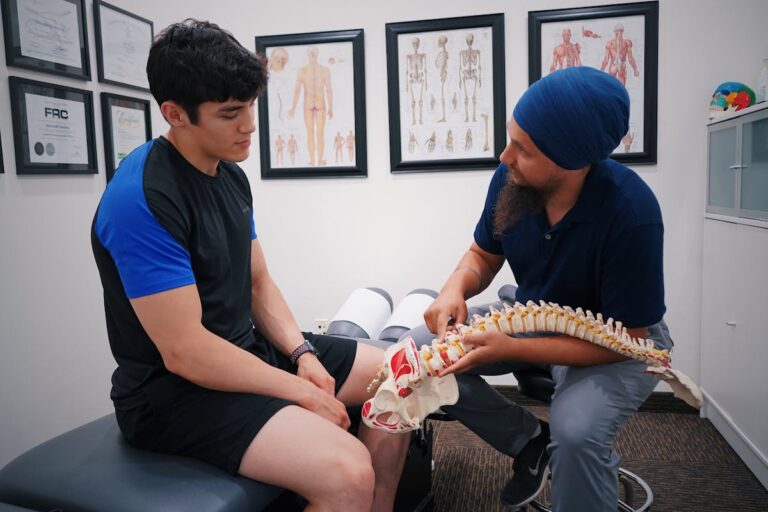With the rise of desk jobs in our modern society, musculoskeletal discomfort has become an increasingly common complaint among working professionals. While there are many ways to manage this type of pain, one solution that has shown considerable promise is chiropractic care. This holistic, non-invasive approach addresses the root causes of pain, delivering both immediate relief and long-term benefits. But how exactly does chiropractic treatment work to alleviate desk job-related discomfort, and what can individuals expect from regular sessions with a chiropractor? These are questions worth exploring further.
Understanding Chiropractic Care
Chiropractic care, a non-invasive health discipline, is founded on the premise that the body has the ability to heal itself. Grounded in the chiropractic philosophy, this holistic approach focuses on the diagnosis, treatment, and prevention of mechanical disorders of the musculoskeletal system. The emphasis lies primarily on the spine, considering its vital role in the functioning of the nervous system. Chiropractors believe that spinal dysfunctions can impede the body’s self-healing mechanism, leading to health problems. The role of a chiropractor is to restore normal spinal mobility, thereby alleviating strain on the spinal nerve and re-establishing altered reflexes. This approach does not solely focus on symptoms relief but promotes overall health and well-being, reinforcing the body’s natural ability to heal.
The Connection Between Desk Jobs and Pain
While many may not consider the implications of a desk job on their health, the reality is that prolonged sitting can lead to a host of physical discomforts and ailments. This is primarily due to inadequate desk ergonomics and poor posture, which can stress the musculoskeletal system, causing pain and discomfort. Pain management becomes a challenge, especially when the root cause – a sedentary lifestyle – is part of one’s daily routine. The constant strain on the neck, back, and shoulders may result in chronic pain, disrupting both work and personal life. Understanding the connection between desk jobs and pain is essential in taking appropriate preventive measures. After all, a healthy workforce is a productive one.
Common Desk Job-Related Ailments
Desk job-related ailments, while common, can greatly impact an individual’s quality of life and productivity. These health issues often stem from prolonged static postures affecting the musculoskeletal system, leading to a variety of postural problems and associated pain. It is paramount to identify and understand these ailments in order to seek appropriate chiropractic care for relief and prevention.
Identifying Desk Job Ailments
Although many may not consider it physically demanding, sitting at a desk for extended periods of time can lead to a variety of health issues. Common ailments include neck and shoulder pain, lower back discomfort, and wrist strain, often exacerbated by poor posture or inadequate ergonomic adjustments. Tension headaches can also occur from prolonged screen time, while leg cramps and circulation issues may arise from lack of movement. Simple office stretches and regular breaks can alleviate some of these symptoms, but professional guidance is advisable for persistent pain. Recognising these ailments is the first step towards ensuring better health in desk-bound occupations. Remember, even a comfortable chair and desk setup can lead to discomfort without proper self-care.
Impact on Musculoskeletal Health
Given the sedentary nature of desk jobs, the impact on musculoskeletal health can be considerable. Hours of sitting can lead to muscle tension and joint stiffness, creating discomfort and potentially leading to long-term issues. These conditions often manifest in the neck, shoulders, and back, but can affect the entire body.
The persistent strain from poor ergonomics and limited movement can cause chronic pain and impairment. Further, the lack of physical activity contributes to muscle weakness and joint instability. Understanding these risks is essential to mitigating them.
Chiropractic care offers a non-invasive approach to alleviate these symptoms. Regular adjustments can help maintain mobility, reduce discomfort, and promote overall musculoskeletal health. Ultimately, proactive solutions can greatly improve quality of life for those with desk jobs.
Postural Problems and Pain
The persistent discomfort and chronic pain associated with desk jobs often stem from postural problems. Poor posture places undue stress on your spine, leading to misalignment and discomfort. Over time, this can cause severe and chronic pain, impacting your overall physical health and productivity.
The solution often lies in ergonomic adjustments to your workspace. These adjustments can facilitate better posture, reducing the strain on your back and neck. In addition, regular chiropractic care can help maintain proper spinal alignment, additionally alleviating pain and discomfort. With the right combination of chiropractic care and ergonomic adjustments, you can greatly improve your posture and mitigate the physical stresses associated with desk jobs. Remember, a proactive approach to your health can lead to a more comfortable and productive work life.
How Chiropractors Address Neck Pain
Experiencing a stiff, painful neck after a long day at a desk job is a common complaint. Chiropractors often address this issue through neck adjustments, a procedure that realigns the vertebrae in your neck, restoring normal movement and reducing pain. This treatment is particularly effective when combined with ergonomic assessments. By evaluating your workstation setup and posture, chiropractors can identify factors contributing to your neck pain. They may recommend adjustments to your chair height, monitor position, or keyboard arrangement to alleviate strain on your neck. Through a combination of targeted chiropractic care and personalized ergonomic solutions, you can find relief from the chronic neck discomfort that often accompanies desk jobs. Seek professional help to improve your workplace comfort and overall health.
Alleviating Back Discomfort With Chiropractic Techniques
Back discomfort, a common complaint among individuals with desk jobs, can greatly impact productivity and overall quality of life. Chiropractic techniques offer a non-invasive and drug-free approach to relieving such discomfort. In the following discussion, we will explore these techniques and how they can provide effective solutions for backache.
Understanding Chiropractic Techniques
Sedentary occupations often lead to persistent back discomfort, a common affliction for desk job workers. Chiropractic techniques, particularly manual therapy and spinal manipulation, can offer considerable relief. Manual therapy involves hands-on techniques designed to improve tissue extensibility, increase range of motion, induce relaxation, mobilize or manipulate soft tissue and joints, and manage pain. Similarly, spinal manipulation is a high-velocity, low-amplitude thrust that’s applied to the spinal joints. This technique helps restore structural alignment, improve functionality, and alleviate back pain. Understanding these techniques can empower individuals to seek appropriate care. Remember, each technique is performed by a trained professional who thoroughly understands the human musculoskeletal system. It’s a safe, non-invasive option for those seeking relief from the discomfort of a desk job.

Chiropractic Solutions for Backache
While desk jobs may seem relatively low-risk, they’re often the culprits behind chronic backaches. Many office workers spend long hours hunched over computers, leading to postural problems and spinal misalignments. This is where chiropractic adjustments come into play. These precise maneuvers are designed to realign the spine, relieving pressure on the nerves and muscles, effectively alleviating back discomfort.
Moreover, chiropractors also conduct ergonomic assessments to identify hazards in your workplace setup that may be contributing to your backache. They provide personalized advice on ideal workstation setup, correct posture, and regular movement breaks to prevent future discomfort.
Thus, chiropractic care offers a holistic, non-invasive solution for backaches, enhancing your overall wellbeing and productivity at the workplace.
Preventive Measures for Desk Job Pain
To mitigate the discomfort often associated with prolonged periods of sitting, certain preventive measures can be taken. The first step is creating an ergonomic workspace. This involves adjusting your chair and desk to maintain good posture, positioning your computer screen at eye level, and using a suitable keyboard and mouse. It is also essential to take regular breaks from sitting, ideally every 30 minutes.
In addition to these adjustments, incorporating daily stretching routines can greatly reduce discomfort. Simple stretches targeting the neck, back, and shoulders can alleviate tension and improve flexibility.
Benefits of Regular Chiropractic Visits
Despite the effectiveness of preventive measures, desk job pain can persist, making regular chiropractic visits an invaluable part of a thorough pain management strategy. The chiropractic benefits extend beyond immediate relief, including enhanced posture, improved immune response, and increased flexibility. Regular adjustments can help in maintaining ideal spinal health and mitigating the progression of musculoskeletal disorders. This form of care is not merely reactive but also a proactive measure, addressing the root cause and not just the symptoms. Over time, ongoing chiropractic care can also lead to increased energy levels and better overall wellbeing. By making chiropractic visits a regular part of your routine, you are investing in long-term health, potentially preventing future pain and discomfort from desk jobs.
Choosing the Right Chiropractor for You
Having acknowledged the importance of regular chiropractic visits, the next step is finding a chiropractor who can best address your unique needs. This is where chiropractor qualifications come into play. A well-trained professional, with substantial expertise in treating desk job-related conditions, could be your ideal choice. Start by checking the chiropractor’s educational background and relevant certifications.
Further, patient testimonials can offer an insight into the chiropractor’s practice. These testimonials often highlight the practitioner’s personal characteristics, level of care provided, and effectiveness in alleviating discomfort. Such feedback from previous patients can be invaluable in your decision-making process. Remember, your comfort and trust are vital in this therapeutic relationship, encouraging a fruitful path to pain relief.
Frequently Asked Questions
What Are the Potential Side Effects of Chiropractic Treatments?
Potential side effects of chiropractic treatments can include discomfort, fatigue, or mild headaches. Misconceptions often arise regarding treatment frequency; however, it’s tailored to individual health needs, not a one-size-fits-all approach.
How Long Does It Typically Take to See Improvements From Chiropractic Care?
The duration of visible improvements from chiropractic care varies, typically ranging from a few weeks to several months. Factors influencing this include individual health conditions, chiropractic frequency, and the overall length of the treatment plan.
Are There Any Specific Exercises to Pair With Chiropractic Care?
Yes, incorporating specific exercises such as stretching routines and posture exercises can greatly enhance the effectiveness of chiropractic treatments. These exercises can assist in pain relief and in maintaining alignment and balance.
Is It Necessary to Continue Chiropractic Treatments Even After the Pain Subsides?
Continuing chiropractic treatments after pain relief, known as maintenance care, can offer long-term benefits. This preventive approach aids in preventing recurrence and maintaining overall spinal health, enhancing quality of life and productivity.
How Does Chiropractic Care Compare to Other Pain Relief Methods Like Physiotherapy or Medication?
Chiropractic care offers unique benefits in pain management, focusing on holistic body alignment. Compared to physiotherapy or medication, it may provide longer lasting relief and targets the root cause of pain, rather than just treating symptoms.






